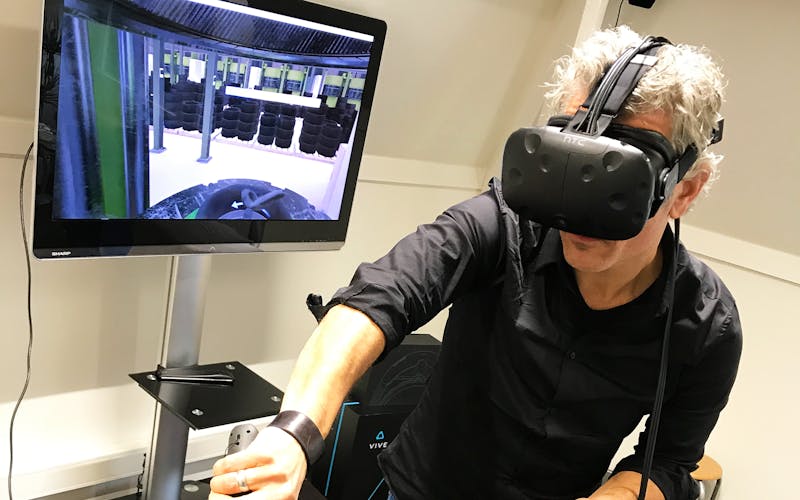What is VR?

VR or Virtual Reality is a term that stands for a digitized or virtualized reality through advanced computer simulations. This technology allows the user to feel present in a simulated world, which is experienced as life-like. VR has applications in the training industry, entertainment sector, but can also be used as a powerful tool in the coaching industry, real estate and healthcare.
Virtual Reality builds on previous ways of letting people experience a non-existent world, such as books, films and 3D movies. VR is perceived as more realistic than almost any other media that creates an alternate reality because, as a participant of this world, you can move around and interact with the virtual reality yourself. To experience a VR world, the user wears VR glasses, which block outside images and project the simulated reality onto the user's retina.
What are the applications of VR technology?
At the moment Virtual Reality is most commonly used as a new form of entertainment. A person wearing VR glasses can travel through the fantasy world of a computer game full of monsters and magical objects. He or she can experience an theme park attraction without stepping out the door, and attend a sports match or concert live as if he or she is present there. 3D movies, museums, digital sports and photo galleries can also be visited in such an alternate reality.
New opportunities for applying VR technology are constantly emerging, and we are increasingly finding them in more 'serious' fields. For example, VR environments are being used by real estate agents or architects to have a VR simulation of a property created, so that its clients can walk through the building without travelling. And also when experiencing online events and parties, a VR simulation can offer a much more complete experience.
Finally, this technology allows companies to offer practical lessons in VR to their employees. In these interactive lessons, a practical situation is experienced and the user can learn the workflow and follow complex procedures and experience dangerous work without consequences.
What opportunities does present VR to companies?
Some of the most interesting business applications of VR technology are in the fields of training, therapy and coaching. People who want to give a speech, lesson or sales presentation themselves can practize it 'live' in front of a simulated VR audience. The technology can also be used to teach users with stage fright, fear of failure or trauma to deal with their blockages step by step and get rid of them. And the range of Virtual Reality training is growing every year.
When using special VR controllers, employees can follow Virtual Reality training. In the training they are in a simulated working environment, with which they can interact. Here, they can, for instance, pick up objects, operate machines and perform complex procedures. In this way, they quickly learn to function in a (future) workplace. This type of training is already being used to train medics, pilots, security guards and train drivers, among others.

VR training is extremely realistic and can be fully adapted to the practical situation. If a mistake is made by the user, there are no serious consequences. And the advanced display of the virtual world and the challenge of interactivity keep the user alert and motivated.
De biggest advantages and disadvantages of VR and VR training.
VR training has a few advantages and disadvantages for companies.
Advantages of VR training
* Lower training costs: the practical components of especially expensive training courses, such as pilot training, can be offered at much lower cost with simulation.
* Remote training: employees do not have to be present at a real workplace, but can be prepared for their jobs on the other side of the world, so to speak. They can even learn to work in a business environment that does not physically exist at the time.
* Faster and better learning: the unique realistic VR environment of these training applications ensures that employees complete their training at a faster pace and with fewer mistakes. They also experience the VR sessions as motivating and well-tailored to the practical situation they find themselves in.
* A safe environment: training in a VR environment allows trainees to make mistakes without any consequences. Consider, for example, working with high-voltage or dangerous machinery. This greatly reduces the risk of incidents.
Disadvantages of VR training
* Specialized technology is needed: the cost of programming a VR environment has been dropping significantly for years, but there is still a price tag for developing customized training. Training applications that are widely used in the market such as BHV, HACCP and NEN3140 are already available on a license basis for a low fee per user per training.
* Not 100 per cent realistic: apart from on-the-job training itself, a VR world is the most realistic form of training available. Yet it often lacks impulses that are present in the real workplace, such as tactile objects, smells and the feeling of pressure and forces when moving heavy objects.
* Physical discomfort: most users experience VR training without any problems. A very small minority may experience dizziness, nausea or disorientation. For training sessions that are too long, eyestrain and headaches may also occur when using VR headsets for the first time.

